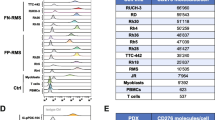Abstract
Anticancer therapy for solid tumors suffers from inadequate methods for the localized administration of cytotoxic agents. Fas ligand (FasL) has been reported to be cytotoxic to a variety of cells, including certain tumor cell lines. We therefore postulated that myoblasts could serve as non-transformed gene therapy vehicles for the continuous localized delivery of cytotoxic anticancer agents such as FasL. However, contrary to previous reports, fluorescence activated cell sorting (FACS) analyses revealed that both primary mouse and human myoblasts express Fas, the receptor for FasL. To avoid self-destruction and test the cytotoxic potential of myoblasts, the cells were isolated from mice deficient in Fas (lpr/lpr), the mouse counterpart of human autoimmune lymphoproliferative syndrome (ALPS). These primary mouse myoblasts were transduced with a retroviral vector encoding mouse FasL and expression of a biologically active and soluble form of the molecule was confirmed by the apoptotic demise of cocultured Fas-expressing Jurkat cells, the standard in the field. To test whether the lpr myoblasts expressing FasL could be used in anticancer therapy, human rhabdomyosarcoma derived cell lines were assayed for Fas and then tested in the apoptosis coculture assay. The majority of Fas-expressingmuscle tumor cells were rapidly killed. Moreover, FasL expressing myoblasts were remarkably potent; indeed well characterized cytotoxic antibodies to Fas were only 20% as efficient at killing rhabdomyosarcoma cells as FasL expressing myoblasts. These findings together with previous findings suggest that primary myoblasts, defective in Fas but genetically engineered to express FasL, could function as potent anticancer agents for use in the localized destruction of solid tumors in vivo by three synergistic mechanisms: (1) directly via Fas/FasL mediated apoptosis, (2) indirectly via neutrophil infiltration and immunodestruction, and (3) as allogeneic inducers of a bystander effect via B and T cells.
Similar content being viewed by others
Literature cited
Nagata, S. and Golstein, P. (1995).Science 267:1449–1456.
Nagata, S. (1997).Cell 88:355–365.
Watanabe-Fukunaga, R., Brannan, C.I., Copeland, N.G., Jenkins, N.A., and Nagata, S. (1992).Nature 356:314–317.
Fisher, G.H., Rosenberg, F.J., Straus, S.E., Dale, J.K., Middleton, L.A., Lin, A.Y., Strober, W., Lenardo, M.J., and Puck, J.M. (1995).Cell 81:935–946.
Ramsdell, F., Seaman, M.S., Miller, R.E., Tough, T.W., Alderson, M.R., and Lynch, D.H. (1994),Eur. J. Immunol. 24:928–933.
Takahashi, T., Tanaka, M., Brannan, C.I., Jenkins, N.A., Copeland, N.G., Suda, T., and Nagata, S. (1994).Cell 76:969–976.
Griffith, T.S., Brunner, T., Fletcher, S.M., Green, D.R., and Ferguson, T.A. (1995).Science 270:1189–1192.
Bellgrau, D., Gold, D., Selawry, H., Moore, J., Franzusoff, A., and Duke, R.C. (1995).Nature 377:630–632.
Hahne, M., Rimoldi, D., Schröter, M., Romero, P., Schreier, M., French, L.E., Schneider, P., Bornand, T., Fontana, A., Lienard, D., Cerottini, J.-C., and Tschopp, J. (1996).Science 274:1363–1366.
Lau, H.T., Yu, M., Fontana, A., and C.J. Stoecker (1996).Science 273:109–112.
Seino, K., Kayagaki, N., Okumura, K., and Yagita, H. (1997).Nature Med. 3:165–170.
Allison, J., Georgiou, H.M., Strasser, A., and Vaux, D.L. (1997).Proc. Natl. Acad. Sci. U.S.A. 94:3943–3947.
Kang, S.-M., Schneider, D.B., Lin, Z., Hanahan, D., Dichek, D.A., Stock, P.G., and Baekkeskov, S. (1997).Nature Med. 3:738–743.
Rando, T.A., and Blau, H.M. (1994).J Cell Biol 125:1275–1287.
Rando, T.A. and Blau, H.M. (1997). InMethods in Muscle Biology, (Ed) Emerson, C.P. and Sweeney, H.L. (Academic Press, San Diego), pp. 261–272.
Springer, M.L., Rando, T.A., and Blau, H.M. (1997). InCurrent Protocols in Human Genetics, (Ed) Boyle, A.L. (John Wiley & Sons, New York), pp. 13.4.1–13.4.19.
McGahon, A.J., Martin, S.J., Bissonnette, R.P., Mahboubi, A., Shi, Y., Mogil, R.J., Nishioka, W.K., and Green, D.R. (1995). InThe End of the (Cell) Line: Methods for the Study of Apoptosis in Vitro, (Ed) Schwartz, L.M. and Osborne, B.A. (Academic Press, San Diego, California), pp. 153–185.
Douglass, E.C., Valentine, M., Ectubanas, E., Parham, D., Webber, B.L., Houghton, P.J., and Green, A.A. (1987).Cytogenet. Cell Genet. 45:148–155.
Hazelton, B.J., Houghton, J.A., Parham, D.M., Douglass, E.C., Torrance, P.M., Holt, H., and Houghton, P.J. (1987).Cancer Res. 47:4501–4507.
Shapiro, D.N., Houghton, P.J., Hazelton, B.J., Germain, G.S., Murti, K.G., Rahman, A., and Houghton, J.A. (1990).Cancer Res. 50:6002–6009.
Trauth, B.C., Klas, C., Peters, A.M., Matzku, S., Moller, P., Falk, W., Debatin, K.M., and Krammer, P.H. (1989).Science 245:301–305.
Rensing-Ehl, A., Frei, K., Flury, R., Matiba, B., Mariani, S.M., Weller, M., Aebischer, P., Krammer, P.H., and Fontana, A. (1995).Eur. J. Immunol. 25:2253–2258.
Bezwoda, W.R., Esser, J.D., Dansey, R., Kessel, I., and Lange, M. (1991).Cancer 68:867–872.
Gussoni, E., Blau, H.M., and Kunkel, L.M. (1997).Nature Med. 3:970–977.
Kang, S.-M., Hofmann, A., Le, D., Springer, M.L., Stock, P.-G., and Blau, H.M. (1997).Science 278:1322–1325.
Kinoshita, S., Su, L., Amano, M., Timmerman, L.A., Kaneshima, H., and Nolan, G.P. (1997).Immunity 6:235–244.
Author information
Authors and Affiliations
Rights and permissions
About this article
Cite this article
Hofmann, A., Blau, H.M. Death of solid tumor cells induced by fas ligand expressing primary myoblasts. Somat Cell Mol Genet 23, 249–257 (1997). https://doi.org/10.1007/BF02674416
Received:
Issue Date:
DOI: https://doi.org/10.1007/BF02674416




